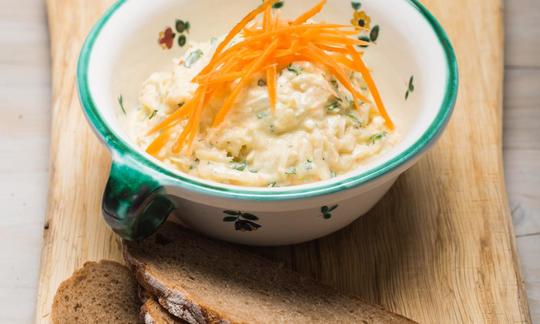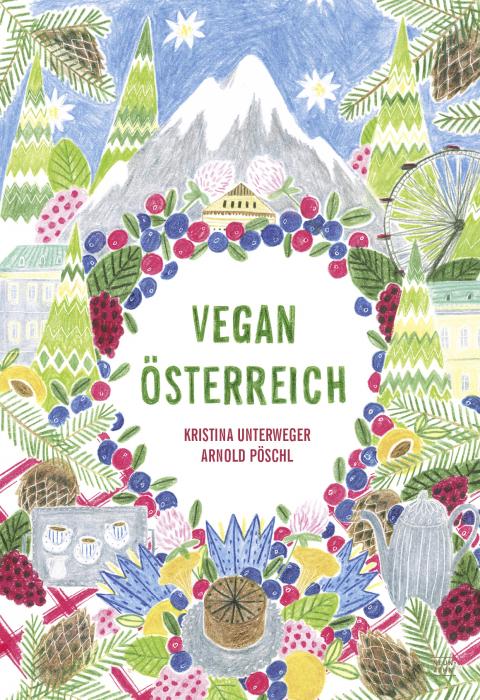Sauerkraut Salad with Carrots and Apples
vegan
Ingredients (for servings, )
| For the salad | |
|---|---|
| ⅔ oz | Rocket, raw (organic?) |
| ½ | Onions, raw (organic?) (1.9 oz) |
| 1 clove | Garlic (organic?) (0.11 oz) |
| 1 ¾ oz | Carrots (carrots), raw (organic?) |
| 1 tbsp | Horseradish, raw (organic?) (0.49 oz) |
| 1 | Apple, raw, with peel (5.3 oz) |
| 8 ½ oz | Sauerkraut, pasteurized (sauerkraut, organic?) |
| For the dressing | |
| 8 ½ oz | Soy yoghurt (raw?, organic?) |
| 1 tbsp | Sunflower oil (cold pressed? raw? organic?) (0.48 oz) |
| 1 tsp | Cumin, seeds (raw, organic?) (0.07 oz) |
| 1 dash | Table salt (table salt, raw?, organic?) (0.01 oz) |
| 1 dash | Black pepper (organic?, raw?) (0.00 oz) |
Equipment
- grater
- refrigerator
Type of preparation
- chop or grind
- food preparation without heating
- cool
- remove the skin
- peel
- grate (shred)
Preparation
For the salad
Wash and coarsely chop the arugula. Peel and chop the onion and garlic. Finely grate the carrot. Wash, peel, and grate the horseradish root. Wash and grate the apple. Combine everything with the sauerkraut.If possible, use raw sauerkraut as is called for in the original recipe. For more information, see the “Notes about recipe” section.
For the dressing
Mix the soy yogurt with the oil, caraway, salt, and pepper and then toss the dressing with the salad.We have intentionally reduced the oil from 2 tablespoons to 1 tablespoon.
Serving
Refrigerate before serving.
|
Nutritional Information per person
Convert per 100g
|
2000 kcal | |
|---|---|---|
| Energy | 96 kcal | 4.8% |
| Fat/Lipids | 4.2 g | 6.0% |
| Saturated Fats | 0.48 g | 2.4% |
| Carbohydrates (inc.dietary fiber) | 13 g | 5.0% |
| Sugars | 7.6 g | 8.5% |
| Fiber | 4.4 g | 17.6% |
| Protein/Albumin | 3.5 g | 7.0% |
| Cooking Salt (Na:477.0 mg) | 1'212 mg | 50.5% |
| Essential micronutrients with the highest proportions | per person | 2000 kcal | |
|---|---|---|---|
| Sodium, Na | 477 mg | 60.0% | |
| Vit | Vitamin E, as a-TEs | 3.2 mg | 27.0% |
| Vit | Vitamin B9, B11 (Folate, as the active form of folic acid) | 49 µg | 25.0% |
| Fat | Linoleic acid; LA; 18:2 omega-6 | 2.5 g | 25.0% |
| Vit | Vitamin K | 18 µg | 24.0% |
| Vit | Vitamin C (ascorbic acid) | 18 mg | 22.0% |
| Elem | Potassium, K | 366 mg | 18.0% |
| Min | Manganese, Mn | 0.34 mg | 17.0% |
| Prot | Tryptophan (Trp, W) | 0.04 g | 17.0% |
| Min | Copper, Cu | 0.16 mg | 16.0% |
Detailed Nutritional Information per Person for this Recipe
The majority of the nutritional information comes from the USDA (US Department of Agriculture). This means that the information for natural products is often incomplete or only given within broader categories, whereas in most cases products made from these have more complete information displayed.
If we take flaxseed, for example, the important essential amino acid ALA (omega-3) is only included in an overarching category whereas for flaxseed oil ALA is listed specifically. In time, we will be able to change this, but it will require a lot of work. An “i” appears behind ingredients that have been adjusted and an explanation appears when you hover over this symbol.
For Erb Muesli, the original calculations resulted in 48 % of the daily requirement of ALA — but with the correction, we see that the muesli actually covers >100 % of the necessary recommendation for the omega-3 fatty acid ALA. Our goal is to eventually be able to compare the nutritional value of our recipes with those that are used in conventional western lifestyles.
| Essential fatty acids | per person | 2000 kcal |
|---|---|---|
| Linoleic acid; LA; 18:2 omega-6 | 2.5 g | 25.0% |
| Alpha-Linolenic acid; ALA; 18:3 omega-3 | 0.08 g | 4.0% |
| Essential amino acids | per person | 2000 kcal |
|---|---|---|
| Tryptophan (Trp, W) | 0.04 g | 17.0% |
| Threonine (Thr, T, irreversibly transaminated) | 0.13 g | 14.0% |
| Isoleucine (Ile, I) | 0.13 g | 11.0% |
| Lysine (Lys, K, irreversibly transaminated) | 0.18 g | 10.0% |
| Leucine (Leu, L) | 0.21 g | 9.0% |
| Phenylalanine (Phe, F) | 0.14 g | 9.0% |
| Valin (Val, V) | 0.15 g | 9.0% |
| Methionine (Met, M) | 0.01 g | 1.0% |
| Vitamins | per person | 2000 kcal |
|---|---|---|
| Vitamin E, as a-TEs | 3.2 mg | 27.0% |
| Vitamin B9, B11 (Folate, as the active form of folic acid) | 49 µg | 25.0% |
| Vitamin K | 18 µg | 24.0% |
| Vitamin C (ascorbic acid) | 18 mg | 22.0% |
| Vitamin A, as RAE | 112 µg | 14.0% |
| Vitamin B6 (pyridoxine) | 0.18 mg | 13.0% |
| Vitamin B7 (Biotin, ex vitamin H) | 4.2 µg | 8.0% |
| Vitamin B1 (Thiamine) | 0.08 mg | 7.0% |
| Vitamin B2 (Riboflavin) | 0.06 mg | 5.0% |
| Vitamin B3 (Niacin) | 0.86 mg | 5.0% |
| Vitamin B5 (Pantothenic acid) | 0.17 mg | 3.0% |
| Essential macroelements (macronutrients) | per person | 2000 kcal |
|---|---|---|
| Sodium, Na | 477 mg | 60.0% |
| Potassium, K | 366 mg | 18.0% |
| Magnesium, Mg | 52 mg | 14.0% |
| Phosphorus, P | 67 mg | 10.0% |
| Calcium, Ca | 54 mg | 7.0% |
| Essential trace elements (micronutrients) | per person | 2000 kcal |
|---|---|---|
| Manganese, Mn | 0.34 mg | 17.0% |
| Copper, Cu | 0.16 mg | 16.0% |
| Iron, Fe | 1.9 mg | 13.0% |
| Zinc, Zn | 0.29 mg | 3.0% |
| Fluorine, F | 44 µg | 1.0% |
| Selenium, Se | 0.61 µg | 1.0% |
| Iod, I (Jod, J) | 2.2 µg | 1.0% |
In "Vegan Austria," Kristina Unterweger and Arnold Pöschl present vegan versions of classic but also more unusual Austrian dishes.
Since this book is written in German, a description is omitted here. If you are interested, please switch to German in the menu.
This sauerkraut salad with carrots and apples can be served as an appetizer or side. It contains lots of healthy ingredients and is a good source of vitamin C.
Sauerkraut: Sauerkraut is white or pointed cabbage that has been fermented by lactic acid bacteria. The production of sauerkraut dates back to the seventh century. Today, sauerkraut is famous around the world as a typical German dish. In order to increase shelf life, sauerkraut is often heated or treated with additives, which causes valuable nutrients to be lost. It is therefore best to buy raw, unpasteurized sauerkraut. In addition to lactic acid, raw sauerkraut contains many essential vitamins and minerals. But unlike pasteurized sauerkraut, raw sauerkraut has a limited shelf life and must be stored in the refrigerator.
Horseradish root: Horseradish root tastes best grated raw. Its pungency makes it particularly good for sauces and dips. Horseradish promotes digestion and is rich in vitamin C and several minerals. It is best to use horseradish root fresh. After washing and peeling, grate the root. Since the essential oils volatilize quickly, the grated root should be used in a recipe or eaten as soon as possible.
Soy yogurt: Soy yogurt is made by adding live bacteria cultures to fermented soy milk We do not regard soy milk and soy yogurt as raw foods since the soy beans are heated during the production process.
Caraway: Caraway is rich in essential oils. Its ability to stimulate the digestive glands and combat flatulence makes it a classic spice in foods that are difficult to digest (e.g., cabbage dishes).
Reducing the amount of oil: We have intentionally reduced the amount of oil in this recipe. If you are interested in reading more about why it is a good idea to reduce your oil intake, please see our detailed review of the book Salt Sugar Fat by Michael Moss.
Raw vegan alternative: If you want to prepare a raw vegan sauerkraut salad, use cashew or almond yogurt in place of the soy yogurt. A recipe for cashew yogurt can be found here. Please note that cashews are seldom raw. Cashews almost always undergo a heating process even if “Raw Cashews” is listed on the label. This usually just means that the toxic cardol they contain has been deactivated by steaming instead of roasting. It is only when the process is explained in detail and controlled that we can be sure the cashews are raw. If you want to ensure that this dish is raw, you can use homemade almond yogurt. To make, simply use almonds instead of cashews following the instructions of the linked recipe above and increase the soaking time to 8–12 hours.




